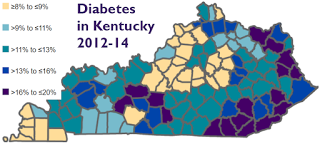1 in 9 in Ky. have been diagnosed with diabetes, and you could have it and not know it; here are symptoms and risk factors

 |
| KentuckyHealthFacts.org map with latest available data, adapted by Kentucky Health News; click on map to view a larger version |
One of nine people have diabetes in Kentucky, which has “all the social ills that cause diabetes to fester,” Laura Ungar and Darla Carter report for The Courier-Journal. “Chief among them is
poverty, which makes it tough to eat well, find safe places to exercise
or get to the doctor and avoid complications such as blindness and
amputations.”
Dr. John Buse, diabetes center director at the University
of North Carolina, told the Louisville newspaper that a colleague once told him: “Diabetes
is a death sentence for the poor and a nuisance for the wealthy.” One in five Kentuckians live below the federal poverty line, third among the states. Other major risk factors include obesity (35 percent of Kentuckians are obese, fifth in the nation) and physical in activity (fourth in the nation).
Diabetes in the state “has skyrocketed in the last two decades and shows no sign of slowing,” the reporters write. “Kentucky’s rate of diagnosed diabetes shot up from 4.3 percent in 1994
to 11.3 percent in 2014, ranking the state sixth worst in a nation that
has seen diabetes double over that time.” The disease “takes thousands of lives each year and the American Diabetes Association estimates
related medical costs and lost productivity total around $3.85 billion
in Kentucky.”
Because those figures are based on poll questions asking people if a doctor has ever told then they have diabetes, the actual numbers are larger because many people have diabetes and don’t know it. The C-J reports, “You may notice no symptoms at all, but here are some common ones, according to the American Diabetes Association:
- Frequent urination
- Feeling very thirsty
- Feeling very hungry – even though you are eating
- Extreme fatigue
- Blurry vision
- Cuts or bruises that are slow to heal
- Weight loss, even though you are eating more (Type 1)
- Tingling, pain or numbness in the hands or feet (Type 2)
consider getting tested for diabetes, especially if you are overweight,” the reporters write. “If you are younger than 45 but are overweight and have one or more
additional risk factors, consider getting tested. They include:
- Having a parent, brother or sister with diabetes
- Being African American, American Indian, Asian American, Pacific Islander or Hispanic American/Latino heritage
- Having a prior history of gestational diabetes or birth of at least one baby weighing more than 9 pounds
- Having high blood pressure measuring 140/90 or higher
- Having abnormal cholesterol with HDL (“good”) cholesterol of 35 or lower, or a triglyceride level of 250 or higher
- Being physically inactive (exercising less than three times a week)